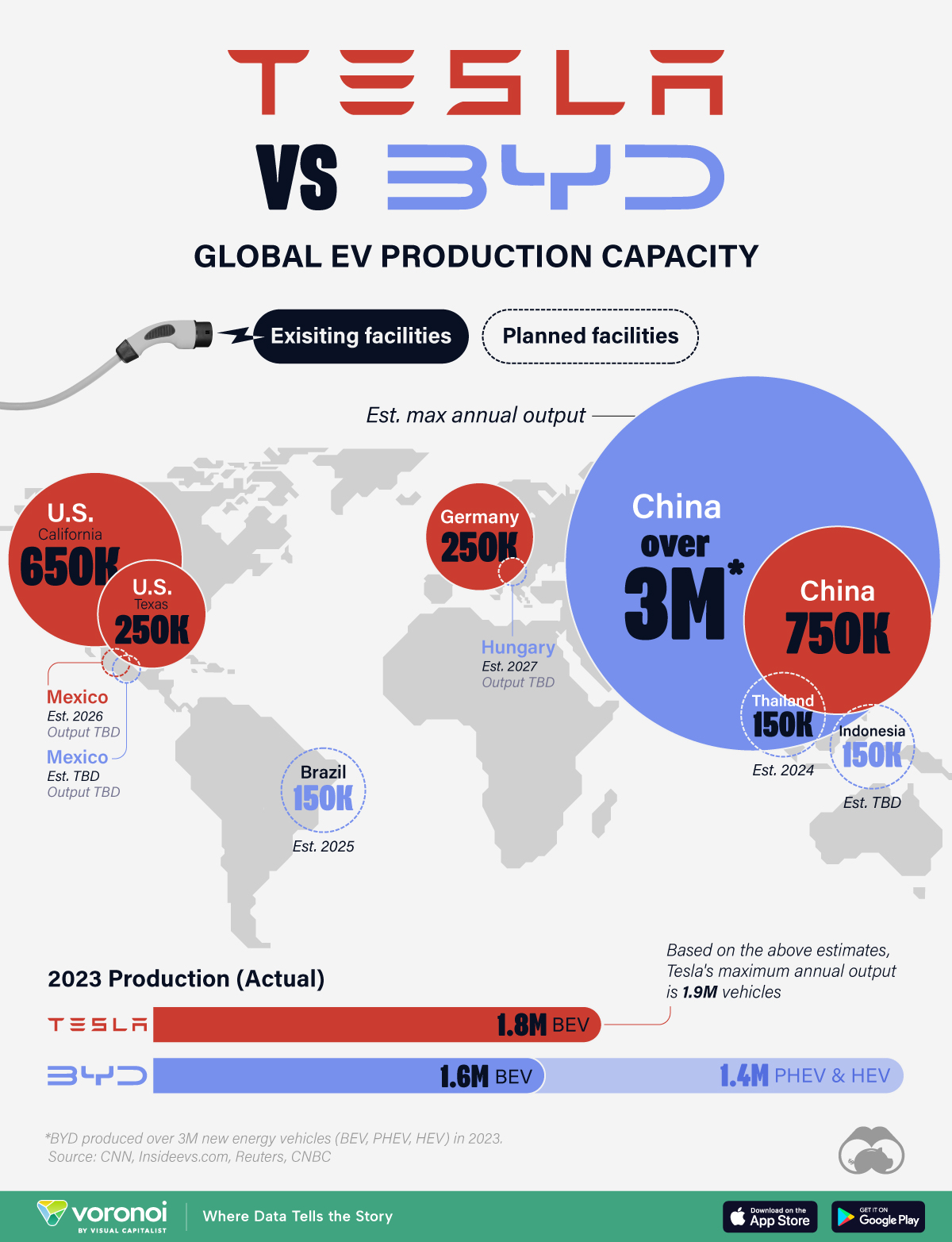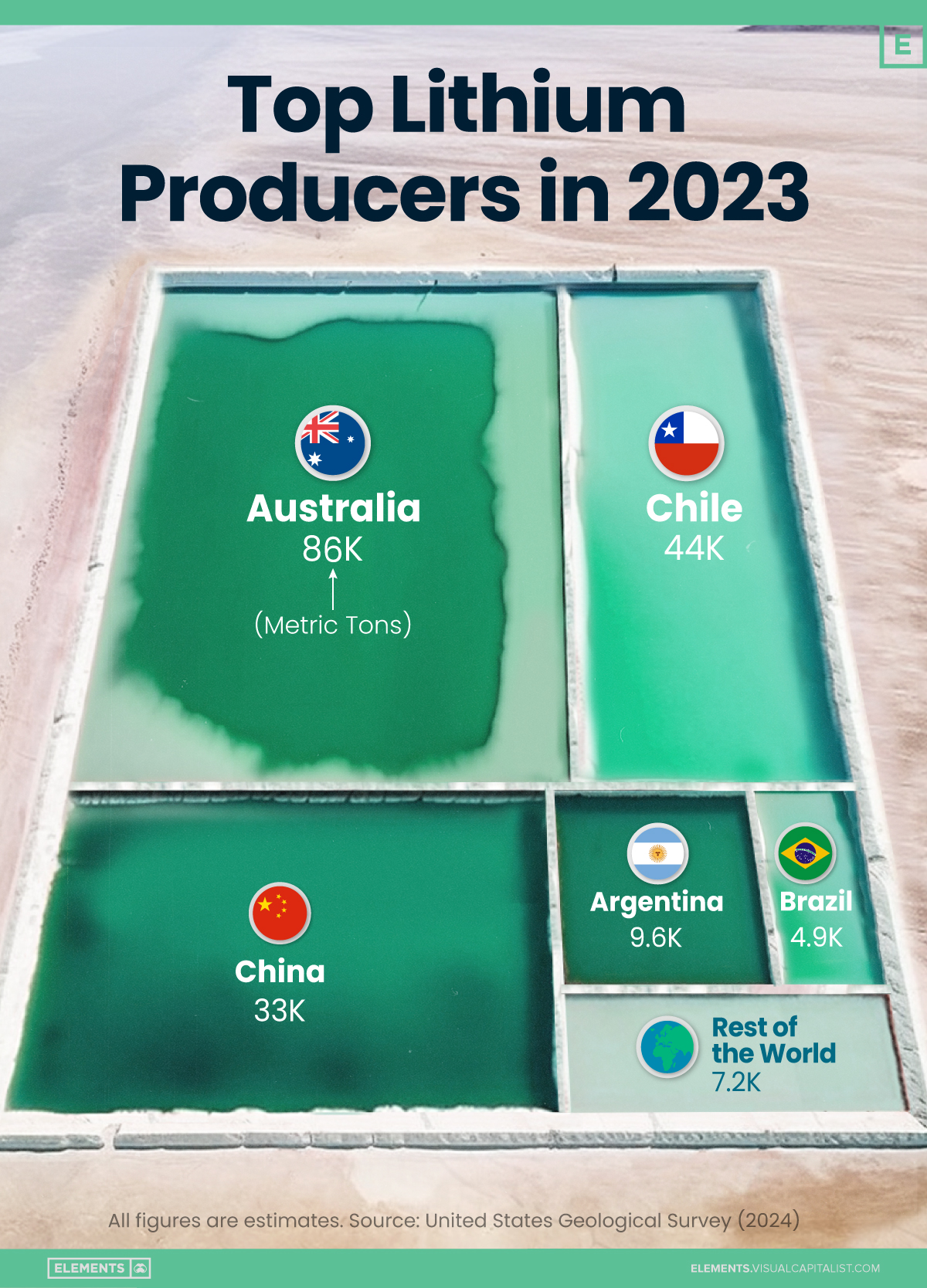
Overview
What we’re showing
This map plots the locations of existing and planned production facilities belonging to Tesla and BYD, currently the world’s two biggest electric vehicle makers.
Figures come from a variety of sources, and represent the latest information pertaining to planned production facilities.
BYD’s aggressive expansion
Although EV demand is not growing as quickly as it was in previous years, BYD is putting the pedal to the floor when it comes to global expansion. The company has announced factories in Europe, Southeast Asia, and Latin America, all to be completed within this decade.
If you’re wondering how the company is able to afford such ambitious plans, consider this: A recent study by Germany’s Kiel Institute determined that BYD has received over $3.7 billion in subsidies from the Chinese government.
| Company | Location | Max Annual Output | Est. Completion |
|---|---|---|---|
| Tesla | Fremont, CA | 650,000 | |
| Tesla | Austin, TX | 250,000 | |
| Tesla | Berlin, Germany | 250,000 | |
| Tesla | Shanghai, China | 750,000 | |
| Tesla | Monterrey, Mexico | TBD | 2026 |
| BYD | Mexico | TBD | TBD |
| BYD | Camaçari, Brazil | 150,000 | 2025 |
| BYD | Szeged, Hungary | TBD | 2027 |
| BYD | China | 3,000,000 | |
| BYD | Raong, Thailand | 150,000 | 2024 |
| BYD | Indonesia (city unknown) | 150,000 | TBD |
| 2023 Production | |||
| Tesla | BYD | ||
| BEV | 1,808,581 | 1,574,804 | |
| PHEV, HEV | 0 | 1,445,196 |
Data sources
BYD produced over 3M new energy vehicles (BEV, PHEV, HEV) in 2023. Given that it had no international factories during that year, we assumed BYD has the capacity to produce 3M+ vehicles in China.
The World’s Largest Lithium Producers in 2023
Three countries—Australia, Chile, and China—accounted for 88% of lithium production in 2023.
In this graphic, we list the world’s leading countries in terms of lithium production. These figures come from the latest USGS publication on lithium statistics (published Jan 2024).
Australia Leads, China Approaches Chile
Australia, the world’s leading producer, extracts lithium directly from hard-rock mines, specifically from the mineral spodumene.
The country saw a big jump in output over the last decade. In 2013, Australia produced 13,000 metric tons of lithium, compared to 86,000 metric tons in 2023.
| Rank | Country | Lithium production 2023E (metric tons) |
|---|---|---|
| 1 | 🇦🇺 Australia | 86,000 |
| 2 | 🇨🇱 Chile | 44,000 |
| 3 | 🇨🇳 China | 33,000 |
| 4 | 🇦🇷 Argentina | 9,600 |
| 5 | 🇧🇷 Brazil | 4,900 |
| 6 | 🇨🇦 Canada | 3,400 |
| 7 | 🇿🇼 Zimbabwe | 3,400 |
| 8 | 🇵🇹 Portugal | 380 |
| 🌍 World Total | 184,680 |
Chile is second in rank but with more modest growth. Chilean production rose from 13,500 tonnes in 2013 to 44,000 metric tons in 2023. Contrary to Australia, the South American country extracts lithium from brine.
China, which also produces lithium from brine, has been approaching Chile over the years. The country increased its domestic production from 4,000 metric tons in 2013 to 33,000 last year.
Chinese companies have also increased their ownership shares in lithium producers around the globe; three Chinese companies are also among the top lithium mining companies. The biggest, Tianqi Lithium, has a significant stake in Greenbushes, the world’s biggest hard-rock lithium mine in Australia.
Argentina, the fourth country on our list, more than tripled its production over the last decade and has received investments from other countries to increase its output.
With all the top producers increasing output to cover the demand from the clean energy industry, especially for electric vehicle (EV) batteries, the lithium market has seen a surplus recently, which caused prices to collapse by more than 80% from a late-2022 record high.


